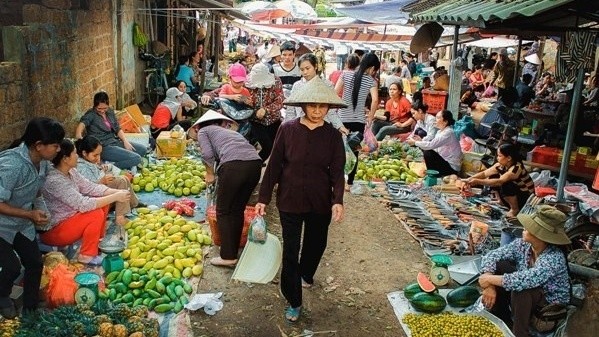Hanoi’s downtown now has many supermarkets and shopping centres, which are full of shoppers during the last days of the lunar month to collect all of the necessary items to prepare for Tet. For those who are too busy, they can just make a call or go online and then ‘chung’ cakes, boiled roosters, and branches of peach flowers will be shipped to their houses.
However, there are also periodical markets in the outskirts of Hanoi. Nguyen Thi Hoa from Kim Lien Apartment Block in Dong Da district revealed that some of the largest periodical markets in Dong Anh district include Sa market in Co Loa commune and To market in Uy No commune, which open for shoppers six times a month.
During the markets’ last session of the year, not only traders but households in the localities gather there to sell their specialities and products. The markets these days are bustling with a cheerful atmosphere as everyone is excited to prepare for Tet.
There are many more popular periodical markets which are held twice every week across Hanoi, including Sa, To and Dau markets (Dong Anh district), Thanh Nhan market (Soc Son district), Nua market (Thach That district), Cao market (Thanh Oai district), Goi market (Dan Phuong district), and Phu market (Quoc Oai district). A few of them are hosted inside spacious buildings but most of them are staged in old tents in an open-air space.
On the last two sessions of 2018 of Sa market in Dong Anh district, a seller was advertising green ‘dong’ leaves, which are used to wrap ‘chung’ cakes, while manually splitting bamboo poles into thin strings. In a tent next to hers, sticky rice was preserved on a large cast-iron pot, shoppers picked up a double handful of rice to test the rice quality and aroma. Vermicelli, black fungus, dried bamboo shoots, mushrooms, and other specialties were also on sale at the market.
The market was crowded with traders and shoppers and full of noise as people were chatting with each other and bargaining with sellers for a more reasonable price. Although supermarkets can offer buyers a wide range of indigenous products, the interaction between buyers and sellers at outdoor markets is so unique that it can bring them closer.
Periodical markets are places where one can buy products made and raised directly by sellers: a bunch of green bananas, chickens, flowers, vegetables, fruits, and other agricultural products. There are also many daily utensils that are not popular any more in big cities, such as baskets and racks made from bamboo.
Despite living in Hanoi for many generations, most Hanoians are rooted from rural villages. Therefore Hanoians still remember their roots so that the traditional cultural practices are still preserved and handed down to younger generations.
















